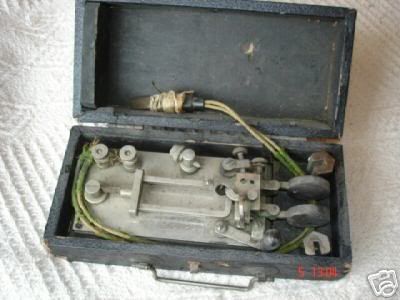No, I didn't “Seize the Key” — or any key for that matter — on eBay. But some collector certainly carpe keyum'ed in a big way yesterday.
This very rare double-lever Dunduplex key shown here sold on eBay for a winning bid of $2,247 — and that's a lot of jack.

The key dates back to about 1909, in the early days of the semi-automatic bug era when Vibroplex was vigorously defending its patented design. If you copied their vibrating arm design too closely, you would be sued, pure and simple.
But that didn't deter a number of entrepreneurs from trying to figure out a way around the Vibroplex patent attorneys.
In the case of the Dunduplex, it used a vibrating arm to make dots in a similar fashion as the Vibroplex.The difference was the Dunduplex system released the tension on a lever to make the dots, To stop the dots, the keying lever damped the spring action by retensioning it — in effect it was an opposite system compared to the Vibroplex vibrating arm.
If you look closely at the photos, you can see that one end of the parallel levers are connected to a single point. There's a spring steel “spring” at this point that provides the vibrating tension, much the way the same material does for a Vibroplex key.
While the idea kept the patent attorneys away, there was still one problem — the key's action. The Dunduplex double lever key had a mushy feel to it compared to a Vibroplex. As you can see in the photo, the Dunduplex vibrating arm looks like a rather convoluted contraption. The Martin Vibroplex was much simpler and outperformed the tensioned lever designs.
The fact that few double-lever Dunduplexes were made and sold is why the bidding on this key was so competitive. Most of these keys are in collectors' hands, and you seldom see one on eBay — unless someone is liquidating the assets of an SK key collector.

NEW BUG A-COMING. Well, it's not really a complete bug, but its an interesting piece of bug history just the same.
I had the winning bid on a rather mangled World War II Vibroplex Original De Luxe. Mangled? Yeah. Someone years ago decided to turn the key into a single lever keyer. The removed the circuit closer and placed a “dot” contact post there. They cut off the keying lever and removed the damper. For obvious reasons, this auction was of little interest to the elite key collectors.
But I see real potential in the key. For starters, its the rather rare World War II De Luxe key — because chrome plating was needed for the war effort, Vibroplex couldn't use that as a way to show it as the “upgraded” key (which came at a higher price).
Instead of chrome, Vibroplex produced the WWII De Luxes with what they called “battleship grey” paint on the base rather than the standard black. The De Luxe keys by WWII had the newer oval thumbpiece and updated finger piece (knob) which were red in color. The De Luxe keys had the jeweled movement as well — they were De Luxes in every sense of the word — save for the lack of chrome on the base.
Vibroplex produced these WWII De Luxes in the 1943-44 period. By 1945 the company was once again using Chrome.
And speaking of material shortages, for several years during the war, the company had to give up the use of brass for its trademark “bug” serial number plate. The company had to make the plates out of plain old tin. The tin plates were painted an orangey-yellow color to resemble the brass tags.
Most WWII-era keys with the tin tags usually have peeling paint, rust or corrosion in general. Finding a WWII key with a perfect tin tag is a rarity too. I have several WWII keys, but only one has a tin tag that's fairly nice. The others have paint loss, etc. Not terrible, but not mint. But what's “mint” when you are considering key sthat are 65-plus years old?
It's a tribute to Horace Martin's design that the keys built long ago survive and are serviceable today.
UPDATE! My T.R. McElroy MAC KEY DELUXE arrived today! I've not unboxed it, but I plan to shortly. More later!
